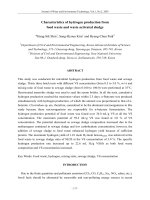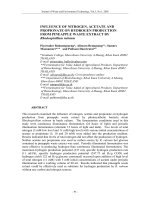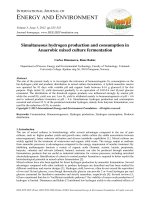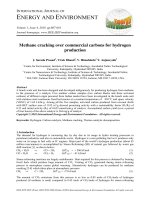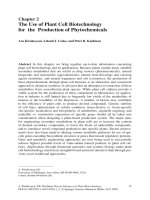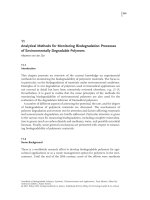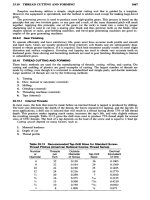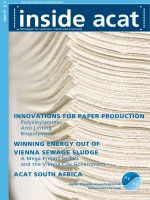membrane reactors for hydrogen production processes
Bạn đang xem bản rút gọn của tài liệu. Xem và tải ngay bản đầy đủ của tài liệu tại đây (4.67 MB, 249 trang )
Membrane Reactors for Hydrogen
Production Processes
Marcello De Falco
•
Luigi Marrelli
•
Gaetano Iaquaniello
Editors
Membrane Reactors
for Hydrogen
Production Processes
123
Editors
Dr. Marcello De Falco
Faculty of Engineering
University Campus Bio-Medico of Rome
via Alvaro del Portillo 21
00128 Rome
Italy
e-mail:
Prof. Luigi Marrelli
Faculty of Engineering
University Campus Bio-Medico of Rome
via Alvaro del Portillo 21
00128 Rome
Italy
e-mail:
Dr. Gaetano Iaquaniello
Tecnimont-KT S.p.A.
Viale Castello della Magliana 75
00148 Rome
Italy
e-mail:
ISBN 978-0-85729-150-9 e-ISBN 978-0-85729-151-6
DOI 10.1007/978-0-85729-151-6
Springer London Dordrecht Heidelberg New York
British Library Cataloguing in Publication Data
A catalogue record for this book is available from the British Library
Ó Springer-Verlag London Limited 2011
HYSEP is a registered trademark of GEA Westfalia Separator GmbH, Werner-Habig Straße, D-59302
Oelde, Germany.
Ole-flex is a registered trademark of Flex-Europa Ltd, Europa House, 4 & 5 Swan Court, Station Road,
Pulborough, West Sussex, RH20 1RL.
PSS is a registered trademark of PSS Interservice AG, Rebbergstr. 10, Geroldswil, Switzerland, 8954.
STAR is a registered trademark of ChromaGenics B.V., Archimedesweg 4, Leiden, Netherlands, 2333 CN.
Apart from any fair dealing for the purposes of research or private study, or criticism or review, as
permitted under the Copyright, Designs and Patents Act 1988, this publication may only be reproduced,
stored or transmitted, in any form or by any means, with the prior permission in writing of the
publishers, or in the case of reprographic reproduction in accordance with the terms of licenses issued
by the Copyright Licensing Agency. Enquiries concerning reproduction outside those terms should be
sent to the publishers.
The use of registered names, trademarks, etc., in this publication does not imply, even in the absence of
a specific statement, that such names are exempt from the relevant laws and regulations and therefore
free for general use.
The publisher makes no representation, express or implied, with regard to the accuracy of the
information contained in this book and cannot accept any legal responsibility or liability for any errors
or omissions that may be made.
Cover design: eStudio Calamar S.L.
Printed on acid-free paper
Springer is part of Springer Science+Business Media (www.springer.com)
A significant increase of interest in membrane reactors in recent years together
with several research programs which are in progress nowadays has pushed the
authors to consolidate their experiences into this book focusing on the more
attracting and promising processes. Few authors have been working together in an
R&D project started in 2006. The goal of this project was the development of a
new scheme for hydrogen production through stream reforming based on inte-
grating chemical reaction and membrane separation.
One of the main objectives of the project was to build a pilot plant with
industrial-size components. Today the pilot plant (see figure below) is running and
the experimental campaigns are allowing to verify the reliability of the novel
scheme and at the same time useful information is generated to assess the plant
operation and for scaling-up the design to future industrial size units.
Semi-industrial
membrane-based steam reformer installed in Chieti Scalo (Italy)
The R&D project was financially supported by the Italian Research Ministry,
and managed by the Chemical Engineering Department of the University of
L’Aquila.
In the next year the experimental program will be oriented both to the theo-
retical aspects of the process and to the technological ones, focusing on the reli-
ability and on the scaling-up criteria for process design of industrial plants.
The research project allowed to compare two different ways of integrating
catalytic reaction and hydrogen separation: one in which the membranes are set
inside the reaction environment (e.g. the membranes constitute the catalytic tube
walls) and another one in which the catalytic module is separated from the
hydrogen permeation one.
With reference to the book content, the authors divided it into 11 chapters. The
book starts with an overview on membrane selective membranes integrated in the
chemical reaction environment. The thermodynamics and kinetics of membrane
reactors are also formulated and assessed for different membrane reactor
architectures.
The rest of the book is divided into three parts. The first part deals with the
membranes, membranes manufacturing and mathematical modeling. The second
v
reviews the most attracting application from an industrial point of view. The third
is dedicated to the description of the pilot plant where the novel configuration was
implemented at a semi-industrial scale.
In Chap. 2, an extensive overview concerning palladium-based membranes is
presented. In particular, an assessment of the problems associated with palladium
membranes is given followed by a description of the preparation methods.
Chapter 3 focuses on a proper membrane manufacturing strategy to improve their
industrial competitiveness by lowering production costs. In Chap. 4, the mathe-
matical modeling strategies focused on the simulations of membrane reactors
(MR) and reactor membrane modules (RMM) are presented. In Chap. 5, the
membrane reactor application to natural gas steam reforming is presented and
assessed in the MR and in the RMM configuration. Chapter 6 is dedicated to the
autothermal reforming reaction (ATR) for syngas production. An higher efficiency
can be achieved integrating in the reactor an H
2
permselective membrane. In
Chap. 7, the water–gas shift reaction is studied. The integration of membranes
inside or outside the shift environment is also analyzed. A techno-economic
analysis is dedicated to the shift reactor integrated with the membrane module
Semi-industrial membrane-based steam reformer installed in Chieti Scalo (Italy)
vi Foreword
compared to the conventional process. In Chap. 8 the H
2
S catalytic cracking
process is analyzed. Also in this case the benefits derived by coupling the Claus
reaction and the hydrogen module separation are examined with reference to
different process configurations. In particular, the high Claus reaction temperature
(900°C) and the low working temperature of ceramic membrane modules (600°C)
are taken into account in the definition of process multi-staged configuration.
Chapter 9 deals with alkanes dehydrogenation. Olefins production by catalytic
dehydrogenation of light alkanes might be an alternative to conventional heavy
hydrocarbons cracking. Also in this case the catalytic membrane reactor might
improve the process yield. In particular is studied the coupling of the Pd–Ag
membrane and catalysts usually used in the dehydrogenation process that need to
operate at low H
2
partial pressures. In Chap. 10 the characteristics of the pilot
plant discussed at the beginning of this foreword are shown in more detail referred
to the process design and to the first positive experimental results.
Each chapter was developed as a whole that can be read without reference to
the others.
Professor Diego Barba
Scientific Director
Foreword vii
1 Integration of Selective Membranes in Chemical Processes:
Benefits and Examples 1
Luigi Marrelli, Marcello De Falco and Gaetano Iaquaniello
2 Pd-based Selective Membrane State-of-the-Art 21
A. Basile, A. Iulianelli, T. Longo, S. Liguori and Marcello De Falco
3 Hydrogen Palladium Selective Membranes:
An Economic Perspective 57
G. Iaquaniello, A. Borruto, E. Lollobattista, G. Narducci
and D. Katsir
4 Membrane Reactors Modeling 79
Marcello De Falco
5 Membrane Integration in Natural Gas Steam Reforming 103
Marcello De Falco
6 Autothermal Reforming Case Study 123
Paolo Ciambelli, Vincenzo Palma, Emma Palo
and Gaetano Iaquaniello
7 Technical and Economical Evaluation of WGSR 143
Paolo Ciambelli, Vincenzo Palma, Emma Palo, Jan Galuszka,
Terry Giddings and Gaetano Iaquaniello
8 Membrane-Assisted Catalytic Cracking
of Hydrogen Sulphide (H
2
S) 161
Jan Galuszka, Gaetano Iaquaniello, Paolo Ciambelli, Vincenzo Palma
and Elvirosa Brancaccio
ix
9 Alkanes Dehydrogenation 183
Moshe Sheintuch and David S. A. Simakov
10 Steam Reforming of Natural Gas in a Reformer
and Membrane Modules Test Plant: Plant Design Criteria
and Operating Experience 201
Marcello De Falco, G. Iaquaniello and A. Salladini
11 Future Perspectives 217
Marcello De Falco, Gaetano Iaquaniello and Luigi Marrelli
About the Editors 225
About the Contributors 227
Index 233
x Contents
List of Contributors
A. Basile, Institute on Membrane Technology of National Research Council (ITM-
CNR), Via P. Bucci Cubo 17/C c/o University of Calabria, Rende (CS), 87036,
Italy
A. Borruto, Department of Chemical Engineering, Materials and Environment,
University of Rome La Sapienza, via Eudossiana 18, 00184, Rome, Italy
E. Brancaccio, Processi Innovativi S.r.l., Corso Federico II 36, 67100, L’Aquila,
Italy
P. Ciambelli, Department of Industrial Engineering, University of Salerno, 84084,
Fisciano (SA), Italy
Marcello De Falco, Faculty of Engineering, University Campus Bio-Medico of
Rome, via Alvaro del Portillo 21, 00128, Rome, Italy
J. Galuszka, Natural Resources Canada, CanmetENERGY, 1 Haanel Drive,
Ottawa, ON, K1A 1M1, Canada
T. Giddings, Natural Resources Canada, CanmetENERGY, 1 Haanel Drive,
Ottawa, ON, K1A 1M1, Canada
G. Iaquaniello, Tecnimont KT, Viale Castello della Magliana 75, 00148, Rome,
Italy
A. Iulianelli, Institute on Membrane Technology of National Research Council
(ITM-CNR), Via P. Bucci Cubo 17/C c/o University of Calabria, Rende (CS),
87036, Italy
D. Katsir, Acktar Ltd., 1 Leshem St, P.O.B. 8643, Kiryat-Gat, 82000, Israel
S. Liguori, Institute on Membrane Technology of National Research Council
(ITM-CNR), Via P. Bucci Cubo 17/C c/o University of Calabria, Rende (CS),
87036, Italy
xi
T. Longo, Institute on Membrane Technology of National Research Council
(ITM-CNR), Via P. Bucci Cubo 17/C c/o University of Calabria, Rende (CS),
87036, Italy
E. Lollobattista, Processi Innovativi S.r.l., Corso Federico II 36, 67100, L’Aquila,
Italy
L. Marrelli, Faculty of Engineering, University Campus Bio-Medico of Rome, via
Alvaro del Portillo 21, 00128, Rome, Italy
G. Narducci, Department of Chemical Engineering, Materials and Environment,
University of Rome La Sapienza, via Eudossiana 18, 00184, Rome, Italy
V. Palma, Department of Industrial Engineering, University of Salerno, 84084,
Fisciano (SA), Italy
E. Palo, Tecnimont KT, Viale Castello della Magliana 75, 00148, Rome, Italy
A. Salladini, Processi Innovativi S.r.l., Corso Federico II 36, 67100, L’Aquila,
Italy
M. Sheintuch, Technion, Technion City, 32000, Haifa, Israel
D. S. A. Simakov, Technion, Technion City, 32000, Haifa, Israel
xii List of Contributors
Integration of Selective Membranes
in Chemical Processes: Benefits
and Examples
Luigi Marrelli, Marcello De Falco and Gaetano Iaquaniello
1.1 Introduction
Integration of reaction and separation in a single unit is a powerful tool to increase
efficiency and economic advantages of many chemical processes. Reactive dis-
tillation, extraction, and adsorption are well-known examples of this technological
resource. Recently, a very promising solution is offered by membrane reactors
(MRs).
A MR is a system coupling reaction and separation of one or more products,
with the separation operation performed by a selective membrane. Although not
yet very used at industrial scale, MRs are attracting the attention of scientists and
engineers in the last two decades, and many interesting articles have appeared in
the literature on their performance and possible application in many fields of
chemical and biochemical industries. An excellent review about these topics has
appeared in 2002 by Sanchez Marcano and Tsotsis [1].
For biotechnological applications, synthetic membranes entrapping enzymes,
bacteria, or animal cells are used in membrane bioreactors disclosing new
important developments mainly due to the increased stability of immobilized
enzymes, the possibility of their continuous reuse and the absence of pollution of
the products. Membrane bioreactors are of great interest as well for the possibility
of continuously removing metabolites whose presence in the reaction environment
could reduce the productivity of the reactor.
In the field of inorganic heterogeneous catalysis, metallic or ceramic membranes
are used to bear the generally more severe thermal conditions. Both dense and
L. Marrelli (&) and M. De Falco
Faculty of Engineering, University Campus Bio-Medico of Rome,
via Alvaro del Portillo 21, 00128 Rome, Italy
e-mail:
G. Iaquaniello
Tecnimont KT, Viale Castello della Magliana 75, 00148 Rome, Italy
M. De Falco et al. (eds.), Membrane Reactors for Hydrogen Production Processes,
DOI: 10.1007/978-0-85729-151-6_1, Ó Springer-Verlag London Limited 2011
1
porous, inert and catalytically active membranes have been used in the different
processes analyzed in the scientific or technical literature. Dense Pd-based mem-
branes or almost dense SiO
2
membranes offer very good selectivity and perme-
ability features in all reactions involving generation or consumption of hydrogen
[2]. Composite membranes made of a dense selective layer supported on a porous
material can represent a technical solution when strong mechanical stresses are
imposed to the membrane. Palladium and its alloy membranes were prepared on
stainless steel supports by the electroless plating technique and on alumina supports
by sputtering or by metal–organic chemical vapor deposition [3–6].
Two main advantages are offered by MRs. If the membrane is very selective
with regard to a specific product, then it is possible to obtain a very pure compound
in the same equipment used to produce it. Furthermore, in the case of reversible
reactions, removing one or more reaction products as they are generated allows
conversions higher than equilibrium values to be reached.
The use of inorganic MRs has been investigated for a number of reactions.
Pd-based membranes, mainly Pd–Ag (23%wt), have been extensively tested for
natural gas steam reforming, which is the main process to produce large amount of
hydrogen. Many experimental works are reported in the literature [7–11], attesting
the good performance in terms of natural gas conversion at much lower operating
temperature than traditional process (methane conversions up to 90–95% at
450–550 vs. 850–1000°C).
The dehydrogenation of cyclohexane to benzene [12] and of ethylbenzene to
styrene [13, 14] have been studied in MRs using glass or alumina membranes.
Even if a conversion increase beyond the equilibrium value has been observed in
all the cases, compared with Pd-based membranes, which are much more selective
with respect to hydrogen, porous membranes are less efficient in improving the
conversion. For example, the conversion of cyclohexane to benzene at 200°C and
1 atm (equilibrium conversion 19%) is 45% in a Vycor glass MR whereas it
becomes 99.7% in a Pd–Ag MR.
A growing interest in the membrane assisted Water–Gas Shift reaction (WGSR)
is manifested by a substantial volume of the published pertinent literature that
could be grouped around the two most popular hydrogen permselective mem-
branes, based either on palladium [15–19] or silica [20–22]. Among them, Basile
et al. [15] studied the WGSR in a palladium MR and showed the importance of the
membrane preparation method in obtaining high-quality membrane materials. The
best membrane increased CO conversion up to 99.89% at about 330° C with a
performance claimed stable for more than 2 months [16].
The most recent application of a silica membrane—prepared by counter-dif-
fusion CVD of TMOS (TetraMethylOrthoSilicate) and oxygen—to H
2
S decom-
position was reported by Akamatsu et al. [23]. It was claimed that using this
membrane and a commercial desulphurization catalyst at 600°C, about 70% H
2
S
diluted in 99% nitrogen was converted in a relatively short residence time of 7 s.
A similar application but with a different process architecture was proposed by
Galuzka et al. [24] and is reported in Chap. 8.
2 L. Marrelli et al.
In general, membrane integration inside the reaction environment involves the
following main benefits:
1. The ability of such a reactor to circumvent thermodynamic limitation of an
equilibrium-controlled process allows the same reactants conversion to be
obtained at a lower temperature or a higher conversion to be reached at the
same temperature.
2. Operating at lower reaction temperatures, new heat integration strategies to
supply heat duty to reactors can be proposed. The use of gas exhausts from a
gas turbine as suggested by [25] or solar heated molten salts [26] could become
applicable and reliable industrial solutions.
3. Lower operating temperatures reduce materials cost as well as increase oper-
ation safety.
4. The expected significant process simplification and intensification would cap-
italize on a new industrial paradigm offered by equipments combining reaction
and separation in one step. New reactors and overall plant design strategy have
to be defined.
In this chapter, a theoretical demonstration of operating benefits for chemical
processes in integrating selective membrane is given to the readers. For practical
cases refer to the following chapters.
1.2 Thermodynamics and Kinetics Background
Reversible reactions are thermodynamically limited since equilibrium conditions
cannot be overcome in the reacting mixture. From a thermodynamic point of view,
equilibrium is represented by a constraint (equilibrium constant) on mole fractions
(or concentrations), temperature, and pressure; this constrain derives from the
second principle of thermodynamics. At equilibrium conditions, no net change in
state variables is observed.
From a kinetic point of view this means that at equilibrium the reaction rate
of the direct reaction is equal to the reaction rate of the inverse reaction. As known,
the reaction rates of the direct and of the inverse reactions generally increase with
the reactant and the product concentrations, respectively. Only when product
concentrations are high enough and reactant concentrations are low enough, i.e.,
when the conversion of a key reactant is high enough, the equilibrium is reached.
Some kinds of reactions (irreversible reactions) require very high conversions to
reach equilibrium conditions at a given temperature, whereas for other reactions a
quite low value of the conversion corresponds to equilibrium. These latter reac-
tions are named reversible reactions according to the thermodynamic statement
that each transformation close to equilibrium is a reversible transformation. In the
case of reversible reactions, the thermodynamic limit can prevent acceptable
conversions to be obtained.
1 Integration of Selective Membranes in Chemical Processes 3
The equilibrium composition depends on temperature and pressure of the
system as well as on the composition of the charge or feed.
A very simple numerical example can be useful to illustrate these subjects.
Let’s consider the following synthesis reaction in gas phase:
A þB , R
Let be K = 1.5 the equilibrium constant, at a given temperature T. At a not too
high pressure P, the equilibrium composition in terms of mole fraction is easily
obtained from the definition of K:
K ¼
y
R
y
A
Á y
B
Á P
À1
ð1:1Þ
If the charge is composed of n
A
0
= 5 mol of A and n
B
0
= 5 mol of B, equi-
librium conversion of A at P = 1 atm, is X
A
= 0.367.
This conversion depends on the charge composition. For example, with n
A
0
= 5
and n
B
0
= 3, at the same temperature and pressure, we get X
A
= 0.274 at equi-
librium, whereas with n
A
0
= 3 and n
B
0
= 5 we get X
A
= 0.399.
The effect of the pressure depends on the phase of reacting system and on the
stoichiometry of the reaction. In the present case of reaction in gas phase with a
negative sum of stoichiometric coefficients, high values of P promote the
conversion.
In any case, higher values of equilibrium conversion can be obtained with a
higher value of the equilibrium constant. For example, with K = 1.5, P = 15 atm
and n
A
0
= n
B
0
= 5 we get X
A
= 0.75.
Since the equilibrium constant K depends on the temperature, a way to change
its value is to change T. In particular, K increases with T for endothermic reactions
and decreases for exothermic reactions according the well-known Van’t Hoff
equation:
d ln K
dT
¼
DH
R ÁT
2
ð1:2Þ
with DH [ 0 for endothermic reactions and DH \ 0 for exothermic reactions.
In the case of exothermic reactions, low temperatures should be required to get
acceptable equilibrium conversions but the corresponding slow reaction rates
should require very high residence time in the reactor.
On the contrary, in the case of endothermic reactions, suitable values of K are
often obtained only at very high temperatures with corresponding unacceptable
heat duties, quick deactivation of catalysts, and technical and economic problems
in construction materials.
These shortcomings can be overcome by removing one or more products from
the reaction environment to prevent the equilibrium composition can be reached,
i.e. maintaining y
R
in Eq. 1.1. at lower values than equilibrium.
4 L. Marrelli et al.
1.2.1 Thermodynamics of Reacting Systems
It is well known that a way to express equilibrium condition in a closed system is
to set Gibbs free energy at its minimum value at constant P and T.
dG ¼ 0 P; T½ ð1:3Þ
Equation 1.3, that is a consequence of the second Principle of Thermodynamics,
states that any change from the equilibrium state at constant T and P involves an
increase of G.
If the system is a multi-component reacting system, Eq. 1.3 can be expressed in
the following form:
X
c
i¼1
a
i
l
i
¼ 0 ð1:4Þ
where a
i
are the stoichiometric coefficients of the components (assumed to be
positive for products and negative for reactants) and l
i
are the chemical potentials
defined as:
oG
on
i
P;T;nj6¼i
¼ l
i
ð1:5Þ
If chemical potentials at system conditions are expressed in terms of fugacities f
i
,
and components are assumed to be pure in the reference state, Eq. 1.4 becomes:
À
Dg
0
R ÁT
¼ ln
Y
"
f
i
ðP; T;z
eq
i
Þ
f
0
i
ðP
È
; TÞ
ai
ð1:6Þ
where Dg
0
¼
P
a
i
Á g
0
i
, g
0
i
are the molar free energies of pure components and z
eq
i
are the mole fractions at equilibrium conditions.
The product at the r.h.s. of Eq. 1.6 is the thermodynamic constant K of the
reaction.
KðP
È
; TÞ¼
Y
"
f
i
ðP; T;z
eq
i
Þ
f
0
i
ðP
È
; TÞ
ai
ð1:7Þ
Therefore, Eq. 1.6 can be written in the following form:
ln Kð P
È
; T޼Dg
0
R ÁT
ð1:8Þ
The value of K depends on the temperature and on the pressure and composition
conditions assumed as reference state. Once pressure and composition are fixed,
equilibrium constant depends on the temperature only.
1 Integration of Selective Membranes in Chemical Processes 5
1.2.2 Affinity and Evolution of Reacting Systems
If a closed system is not at equilibrium, a change of its state variables is observed.
The direction of the system evolution is stated by the second Principle of Ther-
modynamics and corresponds to a positive production of entropy d
i
S [ 0:
d
i
S ¼À
X
c
j¼1
l
j
T
dn
j
!0 ð1:9Þ
where the equality holds at equilibrium conditions. The presence of chemical
reactions in a closed system causes changes in the mole number of reactants and
products which are not independent each other since the stoichiometry of reactions
imposes some constraints.
In the case of r simultaneous reactions and c components, we have:
dn
j
¼
X
r
k¼1
a
j;k
Á dn
k
j ¼ 1 c ð1:10Þ
where n
k
is the degree of advancement of reaction k and a
j
,
k
indicates the stoi-
chiometric coefficient of component j in reaction k.
Using conditions 1.10 in Eq. 1.9 we get:
d
i
S ¼
1
T
X
nr
k¼1
A
k
dn
k
!0 ð1:11Þ
or in terms of entropy production rate:
d
i
S
dt
¼
1
T
X
nr
k¼1
A
k
dn
k
dt
!0 ð1:12Þ
In Eqs. 1.11 and 1.12, A
k
is the affinity of reaction k defined as follows:
A
k
¼À
X
c
j¼1
a
jk
Á l
j
ð1:13Þ
In the case of a single reaction, Eq. 1.12 states that the reaction proceeds in the
direction of increasing n when the affinity is positive while n decreases for A \ 0.
At equilibrium, the affinity of the reaction is zero:
A ¼À
X
c
j¼1
a
j
l
j
¼ 0 Equilibrium condition ð1:14Þ
In the case of multiple reactions, Eq. 1.12 is satisfied even with some terms A
k
dn
k
\ 0 if the summation is greater than 0. Obviously, at equilibrium conditions,
6 L. Marrelli et al.
since d
i
S must be zero for every infinitesimal variation of degrees of advancement,
the affinity of each reaction has to be zero:
A
1
¼ A
2
¼ÁÁÁA
nr
¼ 0 ð1:15Þ
At non-equilibrium conditions, the reaction proceeds from left to right (dn [ 0)
only if A [ 0.
This means (Eqs. 1.6 and 1.13):
Dl
È
þ R ÁT Á ln
^
K
ÂÃ
\0
R ÁT Á ln
^
K Àln K
ÂÃ
\0
ð1:16Þ
where:
^
K ¼
Y
"
f
i
ðP; T; z
i
Þ
f
È
i
ðP
È
; TÞ
ai
ð1:17Þ
In other terms, if
^
K\K mole fractions of products are lower than equilibrium
values and mole fractions of reactants are higher than equilibrium values and the
reaction evolves from left to right.
Vice versa, if
^
K [K the evolution is from right to left. Finally, if
^
K ¼ K, the
reaction is at equilibrium and its evolution stops.
In each case, outside equilibrium condition, the reaction evolves in the direction
corresponding to a decrease of free energy G of the system.
Selective membrane application allows products mole fraction to be reduced
and consequently the condition
^
K\K, i.e., mole fractions of products lower than
equilibrium values, is verified, promoting continuously the reaction from left to
right.
1.2.3 Kinetics of Reversible Reactions
The reaction rate of a reversible reaction is the result of two contributions: the
forward reaction that generates the products (chemical species at the right of
the stoichiometric equation) from the reactants (chemical species at the left of the
stoichiometric equation) and the reverse reaction that proceeds in the opposite
direction.
For instance, in the case of a general reaction:
a
1
A
1
þ a
2
A
2
, a
3
A
3
þ a
4
A
4
ð1:18Þ
the net disappearance rate of A
1
is given by:
Àr
1
¼ r
1;forward
À r
1;reverse
ð1:19Þ
1 Integration of Selective Membranes in Chemical Processes 7
where the forward reaction rate generally increases with the concentration of
reactants A
1
and A
2
whereas the reaction rate of the reverse reaction generally
increases with the concentration of the products A
3
and A
4
.
If the concentrations of the reactants and of the products are such as the forward
reaction rate is higher than the reverse reaction rate, the reaction evolves from left
to right; vice versa the direction of the reaction is from ‘‘products’’ to ‘‘reactants’’
when the product and reactant concentrations make the reverse reaction faster than
the forward reaction.
At equilibrium, no net change is observed in the reaction mixture so that
forward and reverse reaction rates are equal.
Removing a product from the reaction environment usually reduces the reaction
rate of the reverse reaction allowing the reaction to evolve further from left to
right.
1.3 Membrane Reactors
Thermodynamics and kinetics conclusions reported in the previous sections show
that removing one or more products from the reaction environment allows the
reaction to proceed without reaching equilibrium conditions.
A technical way to fulfill this plan is to surround the reacting mixture by a
membrane selectively permeable to one of the products at least (Integrated
Membrane Reactor). As a result, the reaction rate of the reverse reaction is lower
than that of the forward reaction and the conversion increases theoretically to the
value corresponding to the complete depletion of the limiting reactant.
A tubular MR is simply composed of two co-axial tubes with the inner one
made of a material selectively permeable to a product of the reaction.
The reacting stream can be fed to the annular region or to the inner tube. The
region where the reactants are fed and the reaction takes place is called reaction or
retentate region whereas the part of the reactor where the products permeated
through the membrane are collected is the permeate chamber.
In the permeate region, the products are usually swept by a gas easily separable
from them (often water vapor). The sweep gas can move co-currently or counter-
currently with respect to the reacting mixture. Each of these schemes has
advantages and drawbacks.
A schematic representation of these two possibilities is shown in Fig. 1.1. The
reaction chamber is the inner tube where a fixed bed of catalyst is assumed to be
present. The permeate chamber is the annular region between the inner tube and
the shell. In the permeate region, the sweep gas flows in co-current mode in
the case (a) and in counter-current mode in the case (b). One or more products of
the reaction are shown to flow through the membrane from the catalytic-fixed bed
toward the permeate region. However, in co-current scheme an inversion of the
flux is theoretically possible at some distance from the inlet section since the flux
8 L. Marrelli et al.
of a compound occurs from regions with high partial pressures toward those with
lower partial pressures. In co-current mode, both reacting mixture and sweep gas
are relatively poor of products in the inlet section so that some compounds gen-
erated by the reaction can diffuse from the reactor to the permeate chamber; but,
along the axis of the reactor the sweep gas is more and more rich of these com-
pounds where their partial pressure in the reacting mixture decreases due to the
transport through the membrane, the slowing of the reaction rate and the pressure
drop along the catalytic bed. When partial pressures have the same value in the
reaction and permeate chambers, the flux stops. In the next sections of the reactor,
an inverse transport from permeate to the reaction region could occur if the effect
of pressure drop is prevailing on the generating rate due to the reaction.
This anomalous behavior is to be taken into account, but it is usually only a
theoretical oddness.
Obviously, this anomaly is not generally allowed in counter-current mode
where the end section of the reactor is characterized by low pressures of removable
compounds in the reacting region but by a practically pure sweep gas entering into
the permeate region.
In Fig. 1.2, a draft of a reactor for methane steam reforming with multiple
membrane tubes for hydrogen separation, operating in co-current mode, is shown.
Unfortunately, the integrated solution of MRs, although very intriguing for the
compactness of the equipments, presents some technical problems.
Some membranes are sensitive to high temperatures so that they could be
incompatible with the reactor temperature. Furthermore, in an integrated MR,
damage to the membrane needs to stop the system, to unload the catalyst
(if present), to substitute the membrane, and a new start-up of the system.
Due to these main reasons, new configurations called Staged Membrane
Reactor (SMR) or Reformer and Membrane Modules (RMMs) have been proposed
in the technical literature [25–29].
A SMR is a series of modules (RMM) each composed of a traditional reactor
followed by a membrane separation unit. The stream flowing out of the reactor,
rich of reaction products, enters into the separation unit where the selective
membrane removes one of the products. The retentate of the membrane unit is then
fed to the subsequent module. A system of heat exchangers can be present between
each unit and the following one. A system composed of two modules is shown in
Fig. 1.3.
(b) Counter-current mode
(a) Co-current mode
Fig. 1.1 Schemes of feed and sweep gas motion
1 Integration of Selective Membranes in Chemical Processes 9
Fig. 1.2 Multiple
membranes reactor for
methane steam reforming
( />Fig. 1.3 Staged membrane reactor with two modules
10 L. Marrelli et al.
A SMR is not strictly a single equipment but each module and the whole system
offer ‘‘enhanced performance in terms of separation, selectivity, and yield’’ [1].
An optimized design of a SMR requires the evaluation of a number of
parameters such as number of modules, conversion to be achieved in each reactor,
degree of product removal in each membrane unit, temperature distribution etc.
It is easy to realize that a system composed of an infinite number of modules
approaches the behavior of an integrated MR if the reaction volume and the
product removal degree are infinitesimal in each module.
Figure 1.4 shows the RMM test plant having the capacity of 20 Nm
3
/h of pure
hydrogen, developed and fabricated by Tecnimont KT and deeply described in
Chap. 10. The plant, composed by a two-stages natural gas steam reformer ? Pd-
based separation modules, has demonstrated the feasibility of SMR configuration.
Fig. 1.4 20 Nm
3
/h of pure
H2 capacity RMM plant
(Courtesy from
Tecnimont KT)
1 Integration of Selective Membranes in Chemical Processes 11
